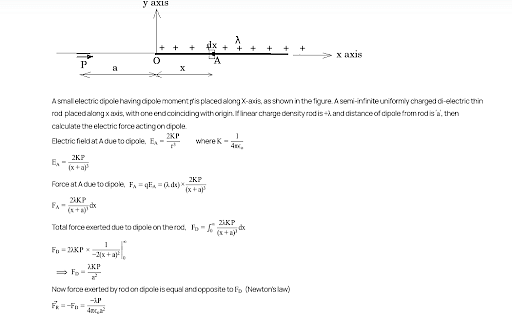Dipole placed in a sphere, what will be the electric flux?
Solution and Explanation
The electric flux through a closed surface is given by Gauss's law, which states that the total electric flux through a closed surface is equal to the enclosed charge divided by the permittivity of the medium.
If the dipole moment is aligned with the normal vector of the surface, the electric flux through the sphere will be zero. This is because the positive and negative charges of the dipole cancel each other's contributions to the electric field at every point on the surface, resulting in no net flux passing through. If the dipole moment is not aligned with the normal vector of the surface, the electric flux through the sphere will be nonzero. In this case, the positive and negative charges of the dipole do not cancel each other completely, resulting in a net electric field passing through the surface of the sphere. This net electric field will lead to a nonzero electric flux through the sphere.
Therefore, the electric flux through the sphere with a dipole inside will depend on the orientation of the dipole relative to the surface of the sphere.
Top Questions on Electric charges and fields
- Two particles each of mass \(2\) kg are places as shown in \(x→ y\) plane. If the distance of centre of mass from origin is \(\frac{4\sqrt 2}{x}\) find \(x\) :

- JEE Main - 2024
- Physics
- Electric charges and fields
- A condenser of $2 \,\mu F$ capacitance is charged steadily from $0$ to $5 C$ Which of the following graph represents correctly the variation of potential difference $(V)$ across it's plates with respect to the charge $( Q )$ on the condenser?
- JEE Main - 2023
- Physics
- Electric charges and fields
Given below are two statements : One is labelled as Assertion $A$ and the other is labelled as Reason R
Assertion A : Two metallic spheres are charged to the same potential One of them is hollow and another is solid, and both have the same radii Solid sphere will have lower charge than the hollow one
Reason R : Capacitance of metallic spheres depend on the radii of spheres
In the light of the above statements, choose the correct answer from the options given belows- JEE Main - 2023
- Physics
- Electric charges and fields
- A 10 μC charge is divided into two equal parts and kept at 1 cm distance. Find repulsion between charges?
- JEE Main - 2023
- Physics
- Electric charges and fields
- Electric field in a certain region is given by $\overrightarrow{ E }=\left(\frac{ A }{x^2} \hat{i}+\frac{ B }{y^3} \hat{j}\right)$ The $SI$ unit of $A$ and $B$ are :
- JEE Main - 2023
- Physics
- Electric charges and fields
Questions Asked in BITSAT exam
NaOH is deliquescent
- BITSAT - 2023
- States of matter
- Minimum value of 5cos(2x) + 5sin(2x)
- BITSAT - 2023
- Trigonometric Functions
- Two capacitors, of capacitance C, are connected in series. If one of them is filled with a dielectric substance K, what is the effective capacitance?
- BITSAT - 2023
- electrostatic potential and capacitance
- The freezing point of the 0.05 molal solution of non - electrolyte in water is? (kf = 1.86)
- BITSAT - 2023
- Solutions
- What is the dimension of the Gravitational constant?
- BITSAT - 2023
- Gravitation
BITSAT Notification
 JCECEB has released Seat Matrix of Online Counselling, Check HereSep 19, 2024
JCECEB has released Seat Matrix of Online Counselling, Check HereSep 19, 2024Concepts Used:
Electric Dipole
An electric dipole is a pair of equal and opposite point charges -q and q, separated by a distance of 2a. The direction from q to -q is said to be the direction in space.
p=q×2a
where,
p denotes the electric dipole moment, pointing from the negative charge to the positive charge.
Force Applied on Electric Dipole




